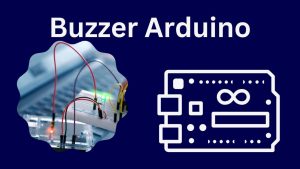Introduction

The Arduino platform stands out for its user-friendliness and adaptability in the realm of DIY electronics and programming. Integrating buzzers has introduced a fascinating avenue for innovation among its numerous applications.
This article explores the realm of Buzzer Arduino projects, illustrating how combining a simple buzzer with Arduino can lead to impressive and creative sound applications.
What is a Buzzer Arduino?
At its core, a Buzzer Arduino setup connects an electronic buzzer to an Arduino microcontroller. This combination enables the creation of diverse sound applications, from basic alarms to intricate musical pieces.
The programmability of the Arduino, paired with the buzzer’s ability to produce sound, offers a unique platform for hobbyists and professionals to explore auditory creativity.
The Components of Buzzer Arduino Projects
Understanding the components involved in Buzzer Arduino projects is crucial for successful implementation.
The Arduino Microcontroller
- Versatility: Arduino boards are celebrated for their versatility, accommodating many projects.
- Ease of Use: Beginners find Arduino approachable due to its straightforward programming language and abundant resources.
The Electronic Buzzer
- Types: Buzzers come in various forms, such as piezoelectric or magnetic, each with unique characteristics.
- Functionality: They convert electrical signals into audible sounds, essential for auditory feedback in projects.
Crafting Your First Buzzer Arduino Project
Embarking on your first Buzzer Arduino project can be exciting and informative.
Step-by-Step Guide
- Assemble the Components: Gather an Arduino board, buzzer, resistors, and connecting wires.
- Circuit Design: Connect the buzzer to the Arduino, ensuring proper orientation and secure connections.
- Programming the Arduino: Write code to control the buzzer’s sound, timing, and melody.
- Testing: Adjust your program to achieve the desired sound output.
Troubleshooting Common Issues
- Wiring Errors: Double-check connections for any loose or misplaced wires.
- Code Debugging: Verify your code for syntax errors or logical issues.
- Power Supply Concerns: Ensure your Arduino receives adequate power for stable operation.
Expanding Your Buzzer Arduino Knowledge
Once you’ve mastered the basics, the possibilities with Buzzer Arduino projects are endless.
Advanced Project Ideas
- Alarm Systems: Design a custom alarm system with distinct sound alerts.
- Musical Instruments: Create an electronic instrument that plays notes or chords.
- Interactive Games: Develop games with auditory feedback using the buzzer.
Frequently Asked Questions about Buzzer Arduino Projects
What is a Buzzer Arduino?
Answer: A Buzzer Arduino refers to the combination of an electronic buzzer with an Arduino microcontroller. This setup allows users to create various sound-based applications, such as alarms, musical tunes, and interactive sound effects.
What are the types of buzzers I can use with Arduino?
Answer: There are mainly two types of buzzers used with Arduino: piezoelectric and magnetic. Piezoelectric buzzers produce sound using the piezoelectric effect, while magnetic buzzers use an electromagnet to create sound. Each type has its characteristics and applications.
How do I connect a buzzer to an Arduino?
Answer: To connect a buzzer to an Arduino, you need to wire the buzzer’s positive terminal to one of the Arduino’s digital output pins and the negative terminal to the ground (GND) pin. Always ensure the connections are secure and correctly oriented.
Do I need additional components to work with a Buzzer Arduino?
Answer: Generally, you need resistors to protect the circuit and connecting wires to establish connections between the Arduino and the buzzer. The exact components can vary based on the specific project requirements.
Can I play melodies using a Buzzer Arduino setup?
Answer: Yes, you can program the Arduino to play melodies by controlling the frequency and duration of the sound produced by the buzzer. This involves writing code that defines the notes and rhythm of the song.
Is programming an Arduino difficult for beginners?
Answer: Arduino programming is relatively beginner-friendly. The platform uses a simplified version of C++, and a vast community and numerous resources are available online to help beginners learn and troubleshoot their projects.
What are some common issues when working with Buzzer Arduino projects?
Answer: Common issues include wiring errors, code bugs, and power supply problems. Double-checking connections, carefully reviewing your code and ensuring a stable power supply can help mitigate these issues.
Can I use a Buzzer Arduino setup in practical applications?
Answer: Absolutely! Buzzer Arduino projects can be used in practical applications like alarm systems, notification devices, and interactive toys. The flexibility of the Arduino platform allows for a wide range of creative and functional implementations.
How can I expand my knowledge in Buzzer Arduino projects?
Answer: To expand your knowledge, experiment with different project ideas, explore advanced coding techniques, and engage with the Arduino community. Online forums, tutorials, and project-sharing platforms are great resources for learning and inspiration.
Where can I find more information and tutorials for Buzzer Arduino projects?
Answer: More information and tutorials can be found on Arduino’s official website, electronic hobbyist blogs, YouTube channels dedicated to DIY electronics, and online forums like Reddit’s r/Arduino and Arduino Stack Exchange.
These questions cover a broad range of topics related to Buzzer Arduino projects and should help readers deepen their understanding and engage more effectively with their projects.
Conclusion
In conclusion, Buzzer Arduino projects represent a fascinating intersection of sound and technology, offering endless possibilities for creativity and innovation.
Whether you are a beginner just starting or an experienced maker looking to explore new ideas, the combination of Arduino’s ease of use and the versatility of buzzers provides a platform for a wide array of sound-based applications. The Buzzer Arduino setup invites you to experiment, learn, and create from simple notification systems to complex musical instruments.
Embrace the challenge, and let your imagination lead the way in discovering the incredible potential of Buzzer Arduino projects. What will you create next in this symphony of sounds and circuits?
